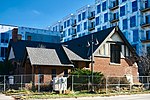Nicking House
Houses completed in 1854Houses in Iowa City, IowaHouses on the National Register of Historic Places in IowaIowa building and structure stubsJohnson County, Iowa Registered Historic Place stubs ... and 2 more
National Register of Historic Places in Iowa City, IowaVernacular architecture in Iowa

The Nicking House is a historic building located in Iowa City, Iowa, United States. Henry C. Nicking, who was a barber, had this house built in 1854. It is one of the oldest houses in the city, and one of a very few that was constructed using sandstone. The general architectural style is a stripped-down version of the Greek Revival style, but a rear addition gives it a saltbox appearance. It features a symmetrical facade, side gable roof, limestone lintels and window sills, and cornice returns on the front. The house was listed on the National Register of Historic Places in 1975.
Excerpt from the Wikipedia article Nicking House (License: CC BY-SA 3.0, Authors, Images).Nicking House
East Market Street, Iowa City
Geographical coordinates (GPS) Address Phone number Website Nearby Places Show on map
Geographical coordinates (GPS)
| Latitude | Longitude |
|---|---|
| N 41.66375 ° | E -91.529638888889 ° |
Address
Mercy Iowa City
East Market Street 500
52245 Iowa City
Iowa, United States
Open on Google Maps










